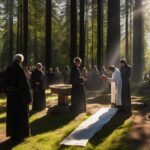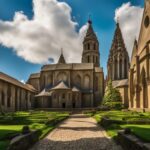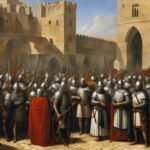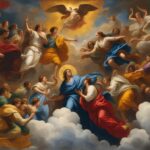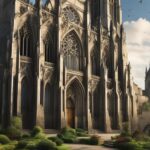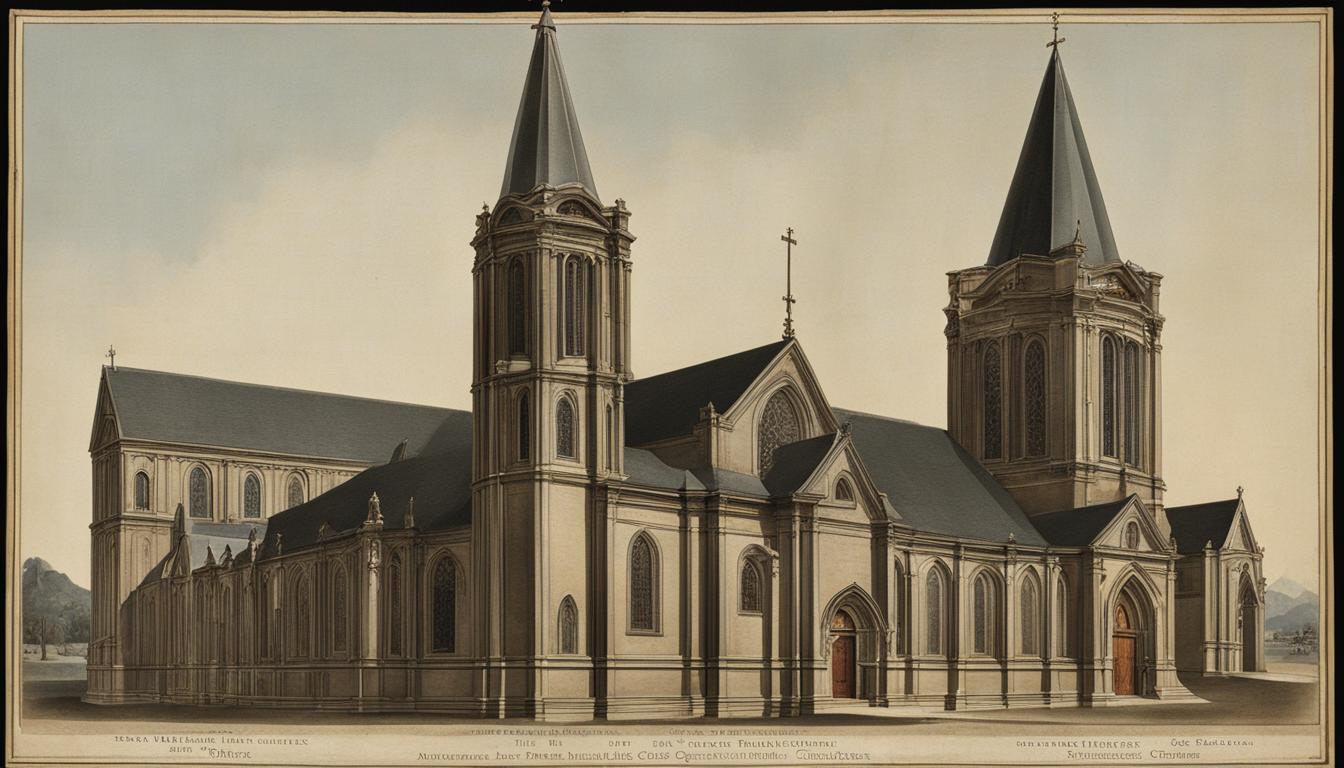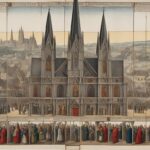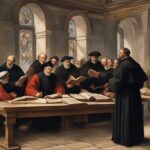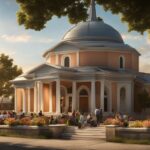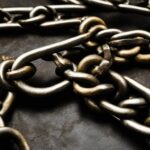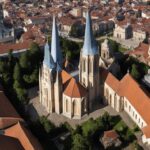The period known as the Middle Ages, or Medieval period, was a time of significant influence and power for the Church. The Church played a central role in shaping society and culture during this time. From the rise of Christianity in medieval Europe to the development of religious institutions, the Church’s impact can be seen in various aspects of medieval life. This article will take you on a journey through the key events, religious practices, and architectural wonders of Medieval Church history.
Key Takeaways:
- Medieval Church history had a profound impact on European society during the Middle Ages.
- The Church’s influence extended to religious practices, architecture, art, and culture.
- The rise of Christianity and the establishment of religious institutions shaped the medieval world.
- The medieval papacy held significant power and often clashed with secular rulers.
- The Church’s legacy can still be seen today in the form of educational institutions and societal norms.
The Rise of Christianity in Medieval Europe
The Middle Ages witnessed the rise of Christianity as the dominant religion in Europe. The Church became an integral part of people’s lives, from the common folk to the nobility. Monasticism and the establishment of religious orders played a crucial role in spreading the teachings of Christianity and preserving knowledge during this time. The Church also became a powerful political and economic institution, exerting influence over kings and shaping the social structure of medieval society.
Religious institutions in the Middle Ages served as centers of learning and governance, contributing to the overall influence of the medieval church. Monasteries and convents served as places of spiritual devotion, where monks and nuns dedicated their lives to prayer, contemplation, and study. These religious orders established libraries and scriptoria, where they meticulously copied and preserved ancient texts, acting as custodians of knowledge.
The influence of the medieval church extended far beyond religious matters. As the Church grew in power and wealth, it became a significant player in European politics. Kings sought the Church’s support and blessing to legitimize their rule, while the Church used its influence to shape the laws and policies of nations. The Church also played a vital role in the economy, owning vast lands and collecting tithes and donations from the faithful.
The Impact on Society
The rise of Christianity had a profound impact on society in medieval Europe. The Church provided a sense of stability and unity in an otherwise tumultuous time. It offered guidance and moral standards, shaping the lives of individuals and communities. The Church’s teachings permeated all aspects of society, influencing laws, customs, and cultural practices.
As the Church grew in power, it also faced challenges and criticism. The influence of the medieval church was not without controversy, with corruption and abuses of power raising questions about its authority. These tensions would eventually lead to the Protestant Reformation in the 16th century, which challenged the doctrines and practices of the Catholic Church.
Major Events in Church History Timeline
The medieval period witnessed several major events that shaped the course of church history. From the crowning of Charlemagne as the Holy Roman Emperor to the schism between the Catholic and Eastern Orthodox Churches, these events had a profound impact on Christianity. Let’s explore some of these significant moments:
The Crowning of Charlemagne (800)
One of the most pivotal events in medieval church history was the crowning of Charlemagne as the Holy Roman Emperor in the year 800. This event marked the beginning of a close relationship between the Church and secular rulers. Charlemagne’s reign saw the expansion of Christianity across Europe and the establishment of a unified Christian empire.
The Great Schism (1054)
The Great Schism of 1054 marked the formal split between the Catholic Church and the Eastern Orthodox Church. This division had far-reaching consequences for both branches of Christianity and created lasting theological and cultural differences. The schism remains an important event in church history, shaping religious and political landscapes in the medieval period and beyond.
The Crusades (1095-1291)
The Crusades were a series of military campaigns launched by the Latin Christian states of Europe to reclaim the Holy Land from Muslim control. These holy wars had a significant impact on church history, fostering religious fervor, promoting trade and cultural exchange, and influencing the development of European society. The Crusades also led to increased contact between Christians and Muslims, shaping interfaith relations.
| Event | Date |
|---|---|
| The Crowning of Charlemagne | 800 |
| The Great Schism | 1054 |
| The Crusades | 1095-1291 |
These major events in church history exemplify the dynamic and often tumultuous nature of the medieval period. They shaped religious, political, and cultural landscapes, leaving a lasting impact on Christianity. The crown of Charlemagne marked the alliance between church and state, while the Great Schism divided Christianity and the Crusades changed the course of European history. Understanding these events is essential to comprehend the development of medieval Christianity and its influence on Western civilization.
Religious Practices in Medieval Europe
Religion played a vital role in the lives of medieval Europeans, with the Church acting as the spiritual and moral compass for society. The religious practices during this time were diverse and deeply ingrained in daily life. From attending church services to participating in sacraments, these practices provided a sense of community and faith.
The clergy, including priests and monks, played a crucial role in conducting religious ceremonies and administering sacraments. Masses were held regularly, and the laity participated in the Eucharist, which was considered a central element of medieval Christian worship. The meditative prayer known as the Rosary became increasingly popular among laypeople, providing a structured way to reflect on the life of Christ.
“The Church in medieval society occupied a central position, providing solace, guidance, and a sense of belonging. The rituals and religious practices brought people together and offered a way to connect with the divine,”
Religious Festivals and Pilgrimages
Religious festivals held throughout the year were another essential aspect of medieval religious practices. These festivals celebrated key events in Christian theology, such as Christmas and Easter, and provided opportunities for communal worship and festivities. Processions, feasting, and performances were often part of these celebrations.
Pilgrimages also held significant importance in medieval Europe. Every year, thousands of pilgrims journeyed to holy sites such as Jerusalem, Rome, and Santiago de Compostela. These pilgrimages were seen as acts of devotion and penance, offering individuals the opportunity to seek forgiveness and spiritual renewal.
Devotion to Relics and Saints
The veneration of relics and saints was a common religious practice during the Middle Ages. Relics were objects associated with biblical figures, apostles, or saints, believed to possess spiritual power. These relics were enshrined and preserved in churches and monasteries, and pilgrims traveled long distances to visit and pray before them.
The cults of saints also played a prominent role in medieval religious practices. Saints were seen as intercessors between humans and God, and devotion to them offered hope and comfort. People sought the intercession of saints through prayers and the lighting of candles, particularly in times of illness or hardship.
| Religious Practices | Description |
|---|---|
| Attending Church Services | Regularly attending masses and participating in religious rituals. |
| Participating in Sacraments | Receiving sacraments such as baptism, communion, and confession. |
| Praying the Rosary | Engaging in meditative prayer focusing on the life of Christ. |
| Religious Festivals | Celebrating key events in Christian theology with processions, feasting, and performances. |
| Pilgrimages | Journeying to holy sites as acts of devotion and seeking spiritual renewal. |
| Veneration of Relics and Saints | Praying before relics and seeking the intercession of saints. |
The Influence of the Medieval Church on Art and Culture
The Church had a profound impact on the art and culture of the Middle Ages. Religious themes and stories from the Bible were depicted in paintings, sculptures, stained glass windows, and illuminated manuscripts. These artistic creations not only served as visual representations of religious teachings but also played a significant role in educating the largely illiterate population about the Christian faith.

Church architecture also flourished during this period, with the construction of grand cathedrals, monasteries, and abbey churches. These impressive structures not only served as places of worship but also showcased the wealth and power of the Church. The Gothic style of architecture, with its soaring ceilings, intricate stone carvings, and stained glass windows, became synonymous with the medieval Church.
The Impact on Society and Education
“Art is a powerful tool for expressing religious devotion and communicating biblical narratives to the masses.”
In addition to visual arts, the Church played a role in the development of music, literature, and drama. Gregorian chants and liturgical music became an integral part of worship services, while religious texts, such as the Bible and theological writings, were meticulously crafted by monks in illuminated manuscripts. Medieval dramas, known as mystery plays, were performed inside or outside churches, providing moral instruction and entertainment to the community.
The artistic and cultural achievements of the medieval Church have left a lasting legacy. The intricate artwork and architectural marvels continue to inspire awe and admiration, serving as a testament to the devotion and creativity of the time. The influence of the medieval Church on art and culture can still be seen today, reminding us of the significant role that religion played in shaping the history of Western civilization.
| Artistic Creations | Architectural Wonders | Cultural Contributions |
|---|---|---|
| Paintings depicting religious themes | Gothic cathedrals and monasteries | Development of liturgical music |
| Sculptures and carvings | Intricate stone carvings | Writing and illumination of religious texts |
| Stained glass windows | Stained glass windows | Performance of mystery plays |
The Power of the Medieval Papacy
The medieval papacy held significant power and influence throughout the Middle Ages, shaping the course of religious and political history. The popes of this era were not only spiritual leaders but also wielded significant political authority, often engaging in conflicts with secular rulers. Their actions and decisions had far-reaching consequences, impacting both the Church and society as a whole.
One pivotal moment in the history of the medieval papacy was the Investiture Controversy. This conflict, which spanned several decades in the 11th and 12th centuries, centered around the appointment of bishops. The dispute arose between the papacy and secular rulers, particularly Holy Roman Emperors, who sought to control the nomination and installation of bishops within their territories. The controversy highlighted the tension between the Church’s spiritual authority and the secular power of rulers, ultimately resulting in a compromise that reaffirmed the Pope’s authority in matters of religious appointment.
The Investiture Controversy showcased the willingness of the medieval papacy to defend its authority and the independence of the Church from secular interference. It set a precedent for the papacy as a major political force in medieval Europe, willing to engage in conflicts with secular rulers to protect its power and influence.
Another significant event in the history of the medieval papacy was the Great Schism, which took place between 1378 and 1417. This period saw the division of the Catholic Church into multiple rival factions, each claiming legitimacy and electing their own pope. The conflict arose due to disputes over papal succession and accusations of corruption within the Church. The Great Schism had profound effects on the unity and authority of the Church, leading to a loss of credibility and a decline in its moral standing.
The Crusades also played a significant role in shaping the power of the medieval papacy. These military expeditions, launched between the 11th and 13th centuries, were sanctioned by the Church and led to a closer alliance between the papacy and secular rulers. The popes used the Crusades as a means of asserting their authority and rallying support from European monarchs, further strengthening their influence in matters of both religion and politics.
| Event | Year |
|---|---|
| Investiture Controversy | 11th-12th centuries |
| Great Schism | 1378-1417 |
| Crusades | 11th-13th centuries |
The power of the medieval papacy extended beyond religious matters. Popes controlled vast territories known as the Papal States, granting them political as well as spiritual authority. Papal influence reached its height during this period, with the Pope serving as the ultimate arbiter in disputes between rulers and as a symbol of Christendom’s unity. However, the power of the medieval papacy was not without its challenges and criticisms, and its authority would be further tested in the centuries to come.
The Legacy of the Medieval Church
The medieval Church left a lasting legacy that continues to shape modern society. The religious institutions established during this time laid the foundation for education and intellectual pursuits that are still influential today. Monastic orders, such as the Benedictines and Cistercians, not only played a crucial role in spreading Christianity but also preserved knowledge through their scriptoria, where manuscripts were copied and illuminated.
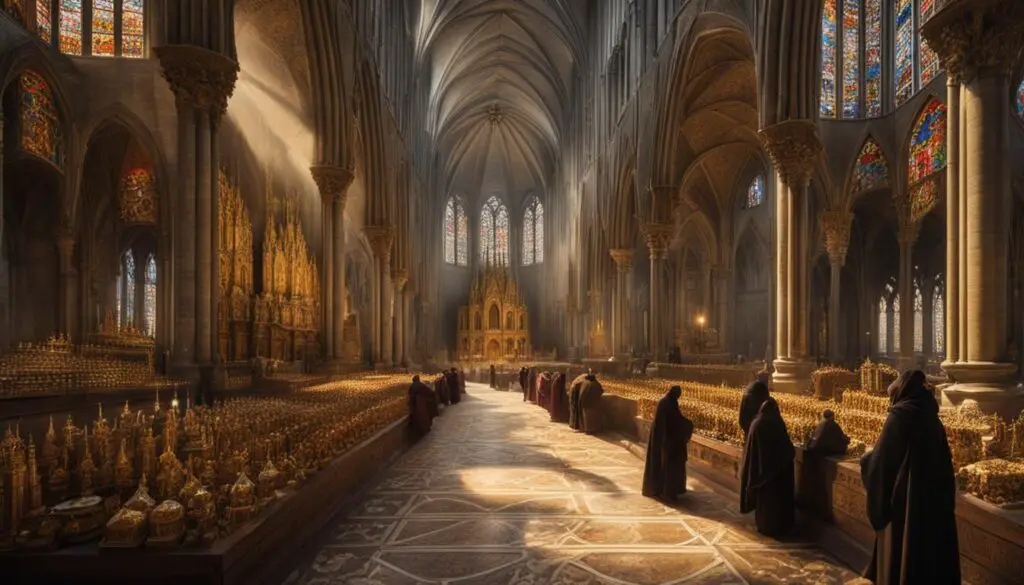
The Church’s influence on moral and ethical values remains evident in societal norms. It provided guidance on matters of conscience and played a significant role in shaping the moral fabric of medieval society.
The Church also left a lasting impact on architecture. The grand cathedrals and monastic buildings of the Middle Ages, such as Notre-Dame Cathedral and Mont Saint-Michel, stand as iconic symbols of religious devotion and human ingenuity. These architectural wonders continue to inspire awe and admiration, showcasing the craftsmanship and artistic excellence of the medieval period.
Overall, the legacy of the medieval Church is seen in the values, education, and architectural achievements that have endured through the centuries. The influence of religious institutions in the Middle Ages and the role of the Church in medieval society continue to shape our understanding of history, spirituality, and culture.
The Legacy of the Medieval Church – Key Points:
- The religious institutions established in the Middle Ages laid the foundation for education and intellectual pursuits.
- Monastic orders played a crucial role in spreading Christianity and preserving knowledge through their scriptoria.
- The Church’s influence on moral and ethical values shaped societal norms.
- Medieval architecture, such as cathedrals and monastic buildings, stands as a lasting testament to the Church’s impact.
- The legacy of the medieval Church continues to shape our understanding of history, spirituality, and culture.
| Religious Institutions in the Middle Ages | Role of the Church in Medieval Society |
|---|---|
| Established monastic orders | Provided spiritual guidance and moral teachings |
| Preserved knowledge through scriptoria | Shaped societal norms and moral fabric |
| Contributed to the development of education | Influenced art, architecture, and culture |
The Role of Women in the Medieval Church
Women played various roles within the medieval Church, contributing to its spiritual, intellectual, and cultural development. While the hierarchy of the Church limited their opportunities for leadership and influence, women found avenues to make significant contributions.
Nuns and abbesses led religious orders, providing spiritual guidance and fostering education and cultural endeavors within their communities. These women not only played crucial roles in preserving religious traditions but also made significant contributions to the arts and sciences. Hildegard of Bingen, for example, was a mystic and composer whose theological and literary works continue to be influential today.
Despite their important contributions, women faced limitations within the Church hierarchy. Only a select few were able to rise to influential positions, such as abbesses or mystic visionaries. However, their contributions cannot be overlooked, as they played an integral role in shaping the spiritual and intellectual landscape of medieval Christianity.
The Role of Women in the Medieval Church – Key Points:
- Nuns and abbesses provided spiritual guidance and fostered education and cultural endeavors within their communities.
- Hildegard of Bingen was a prominent mystic and composer who left lasting theological and literary works.
- Women faced limitations within the Church hierarchy, with few able to attain influential positions.
- Despite limitations, women made important contributions to the spiritual and intellectual development of medieval Christianity.
| Role | Contributions |
|---|---|
| Nuns and Abbesses | Provided spiritual guidance, fostered education, and contributed to the arts and sciences within their communities. |
| Mystic Women | Had profound spiritual experiences, left lasting theological and literary works. |
| Limitations in the Hierarchy | Only a select few women were able to attain influential positions within the Church. |
The contributions of women in the medieval Church were significant, despite the limitations they faced. Through their leadership, intellectual pursuits, and artistic endeavors, women left a lasting impact on the spiritual and cultural fabric of medieval Christianity.
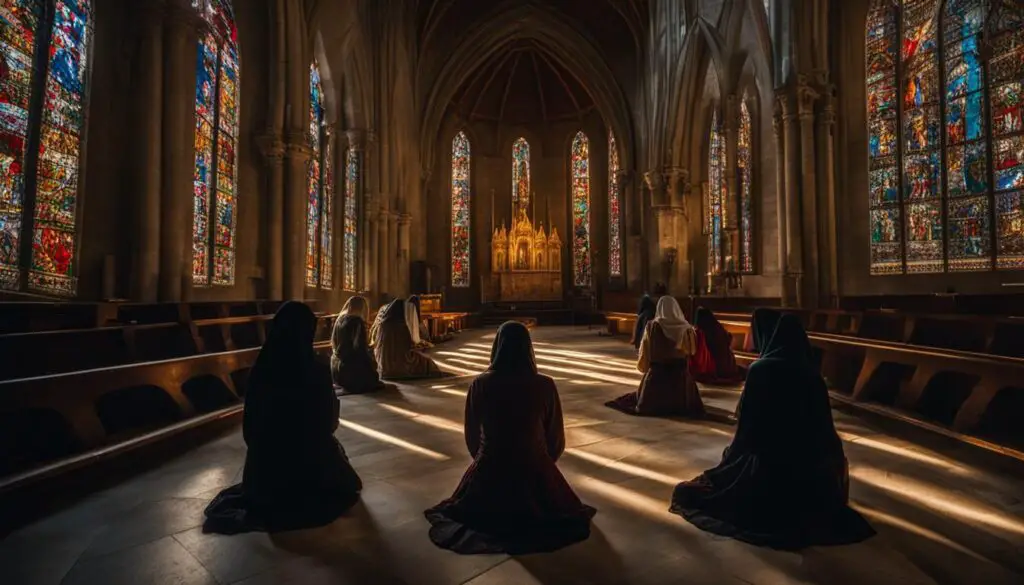
Challenges to the Church’s Authority
During the medieval period, the Church faced numerous challenges to its authority. These challenges took various forms and had significant implications for religious institutions in the Middle Ages. One of the most significant challenges was the Protestant Reformation, which emerged in the 16th century. Led by reformers such as Martin Luther and John Calvin, the Protestant movement questioned the teachings and practices of the Catholic Church. This led to the establishment of Protestant denominations that challenged the authority of the Church and sparked religious and political upheavals throughout Europe.
Another challenge to the Church’s authority was the criticism of its wealth and corruption. Many reformers and intellectuals of the time accused the Church of exploiting its power for financial gain and engaging in immoral practices. This criticism, combined with the emergence of new philosophical and scientific ideas during the Renaissance, further eroded the Church’s influence.
The questioning of traditional religious beliefs and the rise of humanism and scientific inquiry during the Renaissance challenged the authority of the Church. The works of thinkers such as Galileo Galilei and Nicolaus Copernicus contradicted the Church’s teachings and called into question its understanding of the natural world. These challenges to established religious beliefs paved the way for a more secular society and contributed to the eventual separation of church and state.
Church and State Relations in Medieval Europe
The relationship between the Church and the state during the Middle Ages was a complex interplay of power, authority, and conflicts. The Church held immense spiritual influence, providing guidance and legitimacy to rulers, while rulers, in turn, supported and protected the Church. However, tensions often arose over matters of control, authority, and jurisdiction, leading to significant conflicts.
One notable example of such conflict was the Investiture Controversy, which spanned from the 11th to the 12th century. The controversy revolved around the appointment of bishops, with the Pope asserting his authority to appoint them, while secular rulers claimed the right to invest bishops with symbols of temporal power. The conflict resulted in a power struggle between the Pope and Emperor, highlighting the delicate balance of power between Church and state.
“Render therefore to Caesar the things that are Caesar’s, and to God the things that are God’s.” – Matthew 22:21
Even when not engaged in direct conflict, the Church and the state often negotiated terms and agreements to maintain a mutually beneficial relationship. Rulers sought the spiritual support and legitimacy offered by the Church, while the Church relied on the resources and protection provided by secular rulers. This symbiotic relationship allowed both institutions to enhance their influence and maintain stability in medieval Europe.
While conflicts and power struggles were common, the relationship between the Church and the state in the Middle Ages also witnessed moments of collaboration and cooperation. Both institutions recognized the importance of each other’s role in governing society, and their interactions shaped the political, social, and religious landscape of medieval Europe.
| Church’s Role | State’s Role |
|---|---|
| Providing spiritual guidance and legitimacy | Offering protection and resources |
| Preserving knowledge and education through monastic institutions | Maintaining law and order |
| Exerting influence over the masses through rituals and religious practices | Enforcing secular laws and policies |
| Shaping moral and ethical values | Establishing and maintaining political stability |

The Impact of Church and State Relations
The dynamic relationship between the Church and the state in medieval Europe had a profound impact on the development of religious institutions, political structures, and societal norms. It shaped the balance of power and authority, influenced cultural and artistic expressions, and played a crucial role in the preservation and dissemination of knowledge.
The Church’s spiritual authority and close ties with rulers allowed it to exert significant influence over various aspects of medieval society. From the construction of grand cathedrals and monastic buildings to the establishment of religious orders and educational institutions, the Church’s partnership with the state played a pivotal role in shaping the physical and intellectual landscape of Europe.
By studying the complex relationship between Church and state, we gain insight into the dynamics of power and authority during the Middle Ages. It provides valuable historical context for understanding the development of religious institutions, the role of Christianity in medieval Europe, and the influence of both church and state on the lives of individuals.
Conclusion
The Medieval Church History is a fascinating journey through the ages, revealing the immense influence and power of the Church during this period. From the rise of medieval Christianity to the construction of magnificent cathedrals, the Church shaped religious practices, art, architecture, and societal norms.
The medieval papacy emerged as a powerful institution, not only as a spiritual leader but also as a political figure. The Church’s interactions with secular rulers, such as the Investiture Controversy, exemplify the complexities of Church-state relations in the Middle Ages.
The legacy of the Medieval Church continues to resonate in modern society. Its impact on religious institutions, the role of women, and the development of moral and ethical values are still evident today. The architectural wonders and religious art of the Middle Ages stand as a testament to the dedication and ingenuity of the Church and its followers.
FAQ
What is the significance of the Church during the Middle Ages?
The Church played a central role in shaping society and culture during the Middle Ages. It spread Christianity, established religious institutions, and exerted political and economic influence.
What were some major events in Church history during the Middle Ages?
Significant events include the crowning of Charlemagne as Holy Roman Emperor, the schism between the Catholic and Eastern Orthodox Churches, and the rise of the medieval papacy.
How did the Church impact daily life in medieval Europe?
The Church provided spiritual guidance through rituals, sacraments, and religious festivals. The clergy conducted masses and administered sacraments, while pilgrimages and relic veneration were common practices.
How did the Church influence art and culture during the Middle Ages?
The Church’s influence can be seen in religious themes depicted in paintings, sculptures, stained glass windows, and illuminated manuscripts. The construction of grand cathedrals and monasteries showcased the Church’s wealth and power.
What was the role of the medieval papacy?
The medieval papacy held significant power and influence, acting as both spiritual leaders and political figures. They engaged in conflicts with secular rulers and controlled vast territories.
What is the legacy of the Medieval Church?
The Church’s establishment of religious institutions laid the foundation for education and intellectual pursuits. Its influence on moral and ethical values continues to shape societal norms. Its architectural wonders, like Gothic cathedrals, remain iconic symbols of religious devotion.
What role did women play in the Medieval Church?
Women led religious orders, provided spiritual guidance, and contributed to the intellectual and cultural development of their communities. However, they faced limitations within the Church hierarchy.
What challenges did the Church face to its authority?
The Protestant Reformation questioned the Church’s teachings and practices, leading to the establishment of Protestant denominations. The Church’s wealth and corruption were also criticized during this time.
What was the relationship between the Church and the state during the Middle Ages?
The Church provided spiritual guidance and legitimacy to rulers, while rulers provided protection and resources to the Church. Conflicts often arose over matters of authority and power.
What is the conclusion regarding Medieval Church history?
The Medieval Church had a profound influence on medieval society, shaping religion, art, culture, and politics. Its legacy continues to shape modern society, providing insights into the history of Christianity and the development of Western civilization.

